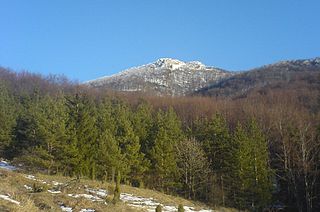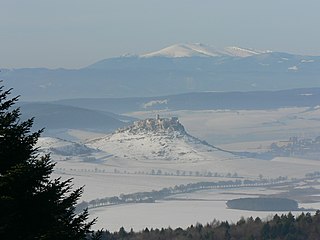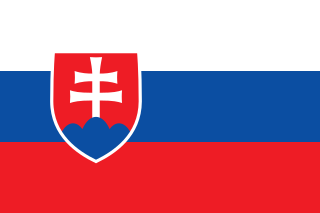
Divisions of the Carpathians are categorization of the Carpathian mountains system.

The High Tatras or High Tatra Mountains, are a mountain range along the border of northern Slovakia in the Prešov Region, and southern Poland in the Lesser Poland Voivodeship. They are a range of the Tatra Mountains chain.

Veľká Fatra is a mountain range in the Western Carpathians in Slovakia. The Veľká Fatra lie to the southeast of the better known Malá (Lesser) Fatra mountains and are less developed, as well as being lower.

Malá Fatra is a mountain range in the Western Carpathians in the north-west of Central Slovakia. In the geomorphological system, it is a part of the Fatra-Tatra Area.
The Kozie chrbty or Kecske-hát are a mountainous area in Slovakia, part of the Fatra-Tatra Area of the Inner Western Carpathians, where uranium ore may be found.

Veľká Fatra National Park is a National Park in Slovakia. Most of it lies in the southern part of the Žilina Region and a small part in the northern part of Banská Bystrica Region. The national park and its protective zone comprise most of the Greater Fatra Range which belongs to the Outer Western Carpathians.

The Strážov Mountains are a mountain range in northwestern Slovakia, being part of Inner Western Carpathians, and of the Fatra-Tatra Area. They are situated between the towns of Trenčín, Považská Bystrica, Rajec, Prievidza and Bánovce nad Bebravou, bordering White Carpathians and the Váh river in the northwest and west, Javorníky in the north, Malá Fatra in the east, Vtáčnik and Nitra river in the south and Považský Inovec in the southwest. The highest mountain is Strážov

The Slovak Central Mountains are a group of mountain ranges in southern central Slovakia. The town of Zvolen lies roughly in the centre of the mountains.

The Staré Hory Mountains is a small mountain range in Central Slovakia, near the town of Banská Bystrica. It is a part of the Low Tatra, which is part of the Fatra-Tatra Area and the Inner Western Carpathians. The mountain range is named after the village of Staré Hory.

Branisko is a mountain range in eastern Slovakia, between the Spiš and Šariš regions. It is a 20 km long and 5 km wide mountain range in the north-south direction, belonging to the Fatra-Tatra Area of the Inner Western Carpathians.

Veľký Rozsutec is a mountain situated in the Malá Fatra mountain range in the Žilina Region, Slovakia. The peak is situated in the north part of Malá Fatra called Krivánska Malá Fatra and is part of the Malá Fatra National Park and Rozsutec National Nature Reserve.

This page gives an overview of the geomorphological division of Slovakia. It is ordered in a hierarchical form, belonging to the Alps-Himalaya System and to the sub-systems of the Carpathian Mountains and of the Pannonian Basin. These subsystems are subsequently divided into provinces, sub-provinces and areas.

Tribeč is a crystalline mountain range in western Slovakia, in the Inner Western Carpathians within the Fatra-Tatra Area, roughly between the towns of Nitra, Partizánske and Zlaté Moravce. It is surrounded by the Danubian Lowland, Pohronský Inovec, Vtáčnik mountains and the Upper Nitra Basin. It is 50 km long and has maximum width of 18 km. Beech trees are predominating in the area. The highest mountain is Veľký Tribeč at 829.6 m (2,722 ft). The area belongs to the Ponitrie Protected Landscape Area.

The Turiec Basin is located in the northern part of central Slovakia, within the Fatra-Tatra Area of the Inner Western Carpathians.

The Podhale-Magura Area — is a geomorfologic region of mountain ranges in northern Slovakia and southern Poland, belonging to the Outer Western Carpathians within the Carpathian Mountains system.

Žiar is a mountain range in the Trenčín Region of northwestern Slovakia, part of the ranges of the Fatra-Tatra Area of the Inner Western Carpathians.

The Súľov Mountains is a rugged mountain range in Slovakia, the northwestern part of the Fatra-Tatra Area of the Inner Western Carpathians. Its highest peak is Veľký Manín, at 890 meters.






















